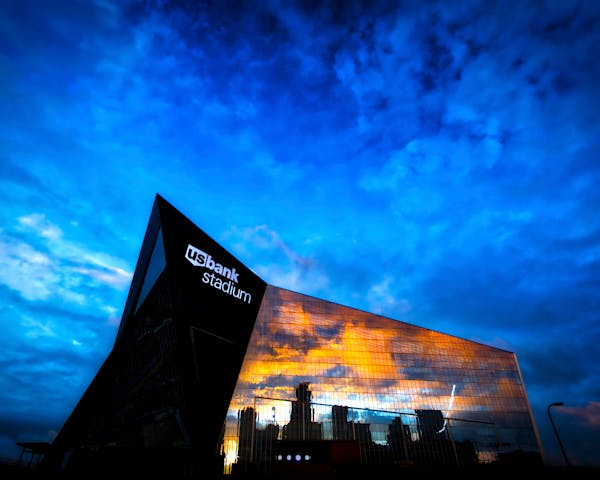The seven-year-old, $1.1 billion U.S. Bank Stadium will be paid off long before the Minnesota Vikings play their first preseason home game in August, under the tax bill signed by Gov. Tim Walz this week.
By the end of June, the state will have retired $377 million in outstanding bonds on the building, saving taxpayers $226 million in interest. The bonds, which have an interest rate of 4.25%, were scheduled to be paid off in 2046.
"I don't like having that debt out there," Walz said.
The governor proposed the payoff in his budget in January. In a session full of big changes, the stadium payoff passed without much attention or friction. The governor didn't even mention it at his bill-signing celebration on the Capitol lawn Wednesday.
While the effort to build the stadium took years of fraught discussions and full-press lobbying by the Vikings, the early payoff was tucked into a giant bill that included $3 billion in tax cuts and $1 billion in new tax revenue. The bill passed the House last weekend and the Senate on Monday.
Vikings Vice President Lester Bagley said the decision is "great news and the latest chapter in a success story that has benefited Vikings fans, the City of Minneapolis and the State of Minnesota. It is a significant accomplishment that the Vikings have been advocating for several years."
The Legislature and Walz also agreed to pay $15.7 million for the first phase of a new secure perimeter at the stadium. Designs for that perimeter are expected to be public next month and the Minnesota Sports Facilities Authority (MSFA) will discuss the project at its monthly meeting Friday.
Most of the money for the building's bond payoff, $366 million, already is in the stadium reserve fund. In 2012, as part of the legislation to build the stadium, the state legalized electronic pulltabs. Tax revenue from the tabs went to make the annual debt payments on the building of about $30 million, a number that included the first few years of payments for Minneapolis.
The excess electronic pulltab revenue above the annual payment went into the stadium reserve. As consumers embraced electronic pulltabs, the revenue soared and the reserve ballooned beyond expectations in recent years. Now the reserve fund will be dissolved, sending an estimated $150 million annually in electronic pulltab tax revenue to the state's general fund.
The stadium, which opened in August 2016, was a public-private partnership. The state issued bonds to cover nearly $500 million. Of that, $349 million was the state's contribution and $150 million was the Minneapolis share of construction. The Vikings owners paid the remainder.
Minneapolis got a break on the interest for its $150 million in the tax bill. Beginning next year, the interest on the city's debt drops from 4.25% to zero. The change saves the city $6.2 million annually through 2046.
Including interest and a separate loan, the deal signed by Walz on Monday relieved Minneapolis of $205 million in stadium debt. The tax bill forgave the principal and interest on a $39.5 million state loan that covered the city's first five years of operating and capital reserve payments on the building.
The new tax law also capped at 3% the share of the city's hospitality taxes that will go toward the stadium and will require the money be used exclusively for capital expenses. Combined with the debt relief, the city will save an estimated total of $350 million through 2046, according to Angie Skildum, Minneapolis development finance director.
Sports facilities authority Chairman Michael Vekich couldn't say Thursday what the impact of that Minneapolis sales tax cap would mean for the stadium, but expected to have numbers Friday.
What the Legislature didn't do was set up a permanent maintenance fund for the state-owned stadium with a dedicated revenue stream, something the Vikings long have lobbied for. The Vikings, the building's primary tenant, have repeatedly noted that the use agreement for the building requires that the state maintain it in a first-class condition.
Bagley's statement said: "We look forward to continuing to work in partnership with the governor and state legislative leaders to address U.S. Bank Stadium's long-term capital needs. It is imperative that we protect this amazing community asset into the future."
The building is going to need work. A consultant's report to the sports facilities authority earlier this year indicated the stadium will need $280 million in maintenance and upgrades in the next decade, including an estimated $48 million next year for the second phase of the perimeter.
"Going forward, that's a further discussion with the governor and legislative leaders for ongoing needs," Vekich said. "Does it come out of bonding? Does it come out of general fund dollars? That's still an open discussion."
Former DFL Senate Majority Leader Kari Dziedzic dies of cancer at age 62

How the Star Tribune is covering the 2024 election

Fact check: Walz and Vance made questionable claims during only VP debate

In Tim Walz's home city, opposing groups watch him debate on the national stage

